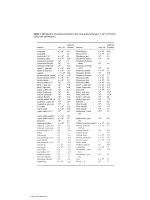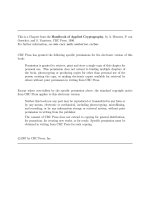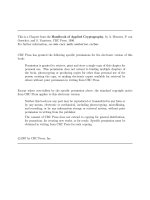Handbook of synthetic photochemistry
Bạn đang xem bản rút gọn của tài liệu. Xem và tải ngay bản đầy đủ của tài liệu tại đây (4.06 MB, 486 trang )
Handbook of Synthetic Photochemistry
Edited by
Angelo Albini and Maurizio Fagnoni
Handbook of Synthetic Photochemistry
Edited by
Angelo Albini and Maurizio Fagnoni
Further Reading
S. Ma (Ed.)
Handbook of Cyclization Reactions
2 Volume Set
2010
ISBN: 978-3-527-32088-2
B. Wardle
Principles and Applications of Photochemistry
2010
ISBN: 978-0-470-01493-6
G.I. Likhtenshtein
Stilbenes
Applications in Chemistry, Life Sciences and Materials Science
2010
ISBN: 978-3-527-32388-3
M. Bandini, A. Ronchi Umani (Eds.)
Catalytic Asymmetric Friedel-Crafts Alkylations
2009
ISBN: 978-3-527-32380-7
N. Mizuno (Ed.)
Modern Heterogeneous Oxidation Catalysis
Design, Reactions and Characterization
2009
ISBN: 978-3-527-31859-9
E.M. Carreira, L. Kvaerno
Classics in Stereoselective Synthesis
2009
ISBN: 978-3-527-32452-1 (Hardcover)
ISBN: 978-3-527-29966-9 (Softcover)
Handbook of Synthetic Photochemistry
Edited by
Angelo Albini and Maurizio Fagnoni
The Editors
Prof. Dr. Angelo Albini
University of Pavia
Department of Organic Chemistry
Via Taramelli 10
27100 Pavia
Italy
All books published by Wiley-VCH are carefully
produced. Nevertheless, authors, editors, and
publisher do not warrant the information contained
in these books, including this book, to be free of
errors. Readers are advised to keep in mind that
statements, data, illustrations, procedural details or
other items may inadvertently be inaccurate.
Library of Congress Card No.: applied for
Prof. Dr. Maurizio Fagnoni
Department of Organic Chemistry
University of Pavia
Via Tamarelli 10
27100 Pavia
Italy
British Library Cataloguing-in-Publication Data
A catalogue record for this book is available from the
British Library.
Bibliographic information published by
the Deutsche Nationalbibliothek
The Deutsche Nationalbibliothek lists this
publication in the Deutsche Nationalbibliografie;
detailed bibliographic data are available on the
Internet at
# 2010 WILEY-VCH Verlag GmbH & Co. KGaA,
Weinheim
All rights reserved (including those of translation into
other languages). No part of this book may be
reproduced in any form – by photoprinting,
microfilm, or any other means – nor transmitted or
translated into a machine language without written
permission from the publishers. Registered names,
trademarks, etc. used in this book, even when not
specifically marked as such, are not to be considered
unprotected by law.
Printed in the Federal Republic of Germany
Printed on acid-free paper
Cover Design Adam-Design, Weinheim
Typesetting Thomson Digital, Noida, India
Printing Strauss GmbH, Mörlenbach
Bookbinding Litges & Dopf Buchbinderei GmbH,
Heppenheim
ISBN: 978-3-527-32391-3
V
Foreword
From its origin over a century ago, organic photochemistry has undergone a
transformation from an area of science populated by a few specialized organic
and physical chemists to a field that now attracts the interest of members of the
broad synthetic organic chemistry community. Along the way, the basic chemical
and physical foundations of the science were developed and the full synthetic
potential of photochemical reactions of organic substrates has been realized.
The science of organic photochemistry can be traced back to observations made in
the nineteenth century, which showed that ultraviolet irradiation of certain organic
substances leads to formation of products that have unique and sometimes highly
strained structures. An example of this is found in studies in the early 1800s, which
demonstrated that irradiation of the naturally occurring, cross conjugated cyclohex
adienone, a santonin, in the crystal state induces a deep seated, multistepped
rearrangement reaction. It is fair to conclude that at that time observations like
this could only have been attributed to the magic of Nature, since little if anything
was known about the fundamental principles of the light absorption process and the
relationships between structures and decay pathways of electronic excited states.
The science of organic photochemistry experienced a significant transformation
in the middle part of the twentieth century when it began to attract the interest of
organic chemists, who were skilled in the use of valence bond theory, and physical
chemists, who were able to probe and theoretically analyze the properties of
electronic excited states. These efforts led to a basic mechanistic framework for
understanding and predicting how electronic excited states of organic substrates
undergo reactions to form products. Clear examples of the insight provided by
organic chemists during this era are found in ground breaking investigations
performed independently by Zimmerman and Chapman that probed the photo
chemistry of simple, cross conjugated cyclohexadienones. The realization that these
processes could be described by utilizing Lewis electron dot line structures of
excited states and reactive intermediates brought organic photochemistry into the
intellectual sphere of organic chemists, who already had learned the benefits of
writing arrow pushing mechanisms for ground state reactions.
Another important contribution to the field of organic photochemistry arose from
investigations of excited state redox processes in the latter part of the twentieth
VI
Foreword
century. These efforts showed that when the oxidation and reduction potentials and
excited state energies of interacting electron donors and acceptors are appropriate,
thermodynamically and kinetically favorable excited state single electron transfer
(SET) will take place to produce ion radical intermediates. This phenomenon
expanded the vista of organic photochemistry, since it enabled the unique and
predictable reactivity profiles of charged radicals to be included in the concept
library used to design new photochemical transformations. Many examples of the
exceptional impact that SET has had on the field of organic photochemistry came
from the pioneering work of Arnold and a cadre of other organic chemists who
developed synthetic applicable SET photochemical processes.
It is clear that studies in the area of organic photochemistry have led to the
discovery of a large number of novel reactions, and that some of these processes
meet the high standards needed for use as preparative methodologies. The compila
tion in this Handbook, which begins with a useful chapter describing practical
experimental methods used in photochemistry, reviews several of the more synthe
tically prominent photochemical reactions of organic substrates.
There is no doubt that the field of organic photochemistry was subjected to
intense scrutiny in the latter half of the twentieth century, and that efforts during
this period led to a firm understanding of basic photochemical principles and to the
discovery of a wealth of highly unique chemical reactions. Moreover, during this
period members of the synthetic organic chemistry community recognized that
several photochemical processes could be applied as key steps in routes for the
construction of complex target molecules. It is likely that activity in the area of
organic photochemistry will not diminish in the twenty first century where it will
used in finding matchless solutions to challenging chemical problems. Thus, rather
than being caused by the need to prepare sophisticated organic substances made by
Nature, problems in the new century are likely to revolve about the search for green
methods for promoting chemical reactions and for processes that can be performed
in confined spaces (e.g., cells), defined patterns (e.g., lithography), and precisely
controlled time domains (e.g., triggers). Organic photochemistry is uniquely applic
able to these types of challenges and, as a result, it should continue to be an
interesting area in which to work.
Patrick S. Mariano
Department of Chemistry and Chemical Biology
University of New Mexico
Albuquerque, NM, USA
VII
Contents
Foreword V
Preface XV
List of Contributors
1
1.1
1.1.1
1.2
1.2.1
1.2.2
1.2.3
1.2.4
1.3
1.3.1
1.3.2
1.3.3
1.3.4
1.4
2
2.1
2.1.1
2.2
2.2.1
2.2.2
2.2.2.1
XVII
Photochemical Methods 1
Angelo Albini and Luca Germani
Photochemical Methods 1
Photochemistry and Organic Synthesis 1
Irradiation Apparatus 2
General 2
Low Pressure Mercury Arcs 3
Medium and High Pressure Mercury Arcs 7
Other Light Sources 9
Further Experimental Parameters 11
Concentration and Scale 11
Effect of Impurities, Oxygen, and Temperature 15
Safety 17
Planning a Photochemical Synthesis 17
Photochemical Steps in Synthetic Planning 19
References 22
Carbon–Carbon Bond Formation by the Photoelimination
of Small Molecules in Solution and in Crystals 25
Saori Shiraki and Miguel A. Garcia Garibay
Introduction 25
Synthesis of Unstable Molecules 27
Photochemical C C Bond Formation in Solution 30
Concerted Reactions 30
Photoelimination of N2 31
Synthesis of Three Membered Rings 31
VIII
Contents
2.2.2.2
2.2.3
2.2.4
2.2.5
2.3
2.3.1
2.3.2
2.3.3
2.3.4
2.3.4.1
2.3.4.2
2.3.4.3
2.3.4.4
2.3.4.5
2.3.4.6
2.3.4.7
2.3.4.8
2.4
3
3.1
3.1.1
3.2
3.2.1
3.2.1.1
3.2.1.2
3.2.1.3
3.2.1.4
3.2.1.5
3.2.1.6
3.2.1.7
3.2.2
3.2.3
3.2.4
3.2.5
3.2.6
3.2.6.1
3.2.6.2
3.3
3.3.1
3.3.2
Synthesis of Cyclobutanes and Polycyclic Compounds 33
Photoelimination of CO from Ketones in Solution 35
Photoelimination of CO2 from Lactones 39
Photoelimination of Sulfur from Sulfides, Sulfoxides,
and Sulfones 40
Reactions in the Solid State 41
Reactivity and Stability in the Solid State 42
Restricting the Fate of the Radical Intermediates in Solids 43
Crystalline Diacyl Peroxides 44
Decarbonylation of Crystalline Ketones 50
Early Observations 50
Reactivity and Stability 51
The RSE > 11 kcal molÀ1 Condition 53
Scope of the Reaction 55
Reaction Enantiospecificity 56
Synthesis of Natural Products 57
Quenching Effects 57
Reaction Scale and Experimental Conditions 59
Concluding Remarks 60
References 60
Intermolecular Addition Reactions onto C–C Multiple Bonds 67
Valentina Dichiarante and Maurizio Fagnoni
Introduction 67
Scope and Mechanism 68
Addition to C C Double Bonds 69
H C Addition (Hydroalkylation Reactions) 69
Addition of Alkanes 70
Addition of Alcohols (Hydrohydroxymethylation), Ethers, and
(2 substituted) 1,3 Dioxolane(s) 71
Addition of Amines (Hydroaminomethylation) or Amides 72
Hydrofluoromethylation 74
Addition of Nitriles or Ketones 75
Hydroacylation and Hydrocarboxylation Reactions 75
Hydroarylation (Photo EOCAS) 76
H N Addition (Hydroamination) 76
H P Addition 78
H O Addition 80
H S Addition 82
Addition of X Y Reagents to Alkenes 83
Halogenation 84
Addition with the Formation of C C Bonds 84
Addition to C C Triple Bonds 86
Hydroalkylation Reactions 87
Addition of X Y Reagents 87
Contents
3.4
Concluding Remarks 88
References 89
4
Formation of a Three-Membered Ring 95
Takashi Tsuno
Introduction 95
Di p Methane Rearrangement 96
Di p Methane Rearrangement of Barrelene, Benzobarrelene,
Dibenzobarrelene, and Related Derivatives 96
Di p Methane Rearrangement of Acyclic Systems 100
Di p Methane Rearrangement in Natural Compounds 103
Oxa di p Methane Rearrangement and Related
Rearrangements 105
Oxa di p Methane Rearrangement of b,g Unsaturated Ketones
and Aldehydes 105
Aza di p Methane Rearrangement 109
Synthetic Applications of Oxa di p Methane Rearrangement 110
[2þ1] Cycloaddition of Alkenes with Carbenes 111
Intramolecular [2þ1] Cycloaddition 111
Novel Triplet Sensitizers for the Generation of Carbenes 111
Metal Catalyzed Cyclopropanation Supported Photochemistry 112
Novel Precursors of Carbenes 113
Formation of a Cyclopropane via Intramolecular Hydrogen
Abstraction 114
Formation of Cyclopropanol via Intramolecular
b Hydrogen Abstraction 115
Formation of Cyclopropane Ring via Intramolecular
g Hydrogen Abstraction 117
[3þ2] Cycloaddition of Arenes with Alkenes 119
Intermolecular [3þ2] Cycloaddition 119
Intramolecular [3þ2] Cycloaddition 119
Application of the Photochemical [3þ2] Cycloaddition in the
Synthesis of Natural Products 122
Photochemical Synthesis of Three Membered Heterocycles 123
Epoxides 123
Aziridines 123
References 126
4.1
4.2
4.2.1
4.2.2
4.2.3
4.3
4.3.1
4.3.2
4.3.3
4.4
4.4.1
4.4.2
4.4.3
4.4.4
4.5
4.5.1
4.5.2
4.6
4.6.1
4.6.2
4.6.3
4.7
4.7.1
4.7.2
5
5.1
5.2
5.3
5.4
5.5
Formation of a Four-Membered Ring 137
Norbert Hoffmann
Introduction 137
[2þ2] Photocycloaddition of Nonconjugated Alkenes 137
[2þ2] Photocycloaddition of Aromatic Compounds 144
Photochemical Electrocyclic Reactions 150
Intramolecular g Hydrogen Abstraction (Yang Reaction) 153
IX
X
Contents
5.6
5.7
5.8
Metal Catalyzed Reactions 156
Other Methods 157
Concluding Remarks 160
References 160
6
Formation of a Four-Membered Ring: From a Conjugate Alkene 171
Jörg P. Hehn, Christiane Müller, and Thorsten Bach
Introduction 171
[2þ2] Photocycloaddition of Enones (Substrate Type A1) 173
Cyclopentenones 173
Cyclohexenones 177
para Quinones and Related Substrates 181
[2þ2] Photocycloaddition of Vinylogous Amides and Esters
(Substrate Classes A2 and A3) 182
Endocyclic Heteroatom Q in b Position (Substrate Class A2) 183
4 Hetero 2 Cyclopentenones 183
4 Hetero 2 Cyclohexenones 185
Exocyclic Heteroatom Q in b Position (Substrate Class A3) 186
[2þ2] Photocycloadditon of a,b Unsaturated Carboxylic Acid
Derivatives (Substrate Classes A4, A5, and A6) 189
No Further Heteroatom Q in b Position (Substrate Class A4) 189
a,b Unsaturated Lactones 189
a,b Unsaturated Lactams 192
Coumarins 193
Quinolones 194
Maleic Anhydride and Derivatives 196
Sulfur Compounds 197
Endocyclic Heteroatom Q in b Position (Substrate Class A5) 198
1,3 Dioxin 4 Ones 198
4 Pyrimidinones 200
Exocyclic Heteroatom Q in b Position (Substrate Class A6) 201
Lactones 202
Lactams 203
Concluding Remarks 205
References 205
6.1
6.2
6.2.1
6.2.2
6.2.3
6.3
6.3.1
6.3.1.1
6.3.1.2
6.3.2
6.4
6.4.1
6.4.1.1
6.4.1.2
6.4.1.3
6.4.1.4
6.4.1.5
6.4.1.6
6.4.2
6.4.2.1
6.4.2.2
6.4.3
6.4.3.1
6.4.3.2
6.5
7
7.1
7.2
7.3
7.4
7.5
Formation of a Four-Membered Ring: Oxetanes 217
Manabu Abe
Introduction 217
The Generally Accepted Mechanism of the Paternò Büchi
Reaction 220
Regioselective and Site Selective Syntheses of Oxetanes 221
Stereoselective Syntheses of Oxetanes 226
Concluding Remarks 233
References 233
Contents
8
8.1
8.2
8.2.1
8.2.1.1
8.2.2
8.2.2.1
8.2.3
8.3
8.3.1
8.3.2
8.3.3
8.4
8.5
8.5.1
8.5.2
8.5.3
9
9.1
9.2
9.2.1
9.2.2
9.2.3
9.2.4
9.3
9.3.1
9.3.2
9.3.3
9.4
9.4.1
9.4.2
9.4.3
9.4.4
9.5
9.6
9.7
Formation of a Five-Membered Ring 241
Ganesh Pandey and Smita R. Gadre
Introduction 241
Formation of Five Membered Rings: Intramolecular d H
Abstraction 241
Formation of Cyclopentanol Ring System 242
Synthesis of Indanols 243
Synthesis of Tetrahydrofuranols 247
Formation of Benzofuranols 250
Synthesis of Pyrrolidine Derivatives 250
Formation of Five Membered Rings via [3þ2] Cycloadditions 254
Photofragmentation of Oxiranes to Carbonyl Ylides: Synthesis of
Tetrahydrofurans 254
Generation of Azomethine Ylides by the Photolysis of Aziridines:
Synthesis of the Pyrrolidine Framework 258
Vinyl Cyclopropane to Cyclopentene Rearrangement 260
Photochemical Electrocyclization Reactions: Synthesis of Fused,
Five Membered Ring Compounds 261
Photoinduced Electron Transfer Mediated Cyclizations: Synthesis
of Five Membered Carbocyclic and Heterocyclic Ring Systems 266
Radical Cation Mediated Carbon Carbon Bond Formation 266
Radical Anion Mediated Cyclizations 272
Intramolecular Trapping of Radical Cations by Nucleophiles 276
References 279
Formation of Six-Membered (and Larger) Rings 287
Julia Pérez Prieto and Miguel Angel Miranda
Introduction 287
Photoelectron Transfer Initiated Cyclizations 287
Phthalimides as Electron Acceptors 287
Aromatic Ketones as Electron Acceptors 291
Chloroacetamides as Electron Acceptors 292
Electron Deficient Aromatic Compounds as Electron Acceptors
Photoinduced 6p Electrocyclization 295
Stilbene Like Photocyclization 295
Vinyl Biphenyls Photocyclization 299
Anilides and Enamides Photocyclization 299
Photocycloaddition Reactions 300
Photochemical Diels Alder Reaction 301
Photoenolization/Diels Alder Reaction 302
[4þ4] Photocycloaddition 302
Transition Metal Template Controlled Reactions 304
Remote Intramolecular Hydrogen Abstraction 307
Ring Contraction and Ring Enlargement 308
Other Reactions 311
293
XI
XII
Contents
9.7.1
9.7.2
9.7.3
9.8
Intramolecular [2þ2] Cycloadditions 311
Photocyclization of Cinnamylanilides 311
Photocycloaddition of Aromatic Compounds 311
Concluding Remarks 313
References 313
10
Aromatic and Heteroaromatic Substitution by SRN1 and SN1
Reactions 319
Alicia B. Peñéñory and Juan E. Argüello
Introduction 319
General Mechanistic Features 320
SRN1 Mechanism 320
SN1 Mechanism 322
Carbon Carbon Bond Formation 323
Carbanions from Ketones, Esters, Acids, Amides, and Imides
as the Nucleophiles 323
Alkenes, Alkynes, Enols, and Vinyl Amines as the Nucleophiles 326
Aryl Alkoxide and Aryl Amide Anions as the Nucleophiles 329
Cyanide Ions as the Nucleophile 331
Carbon Heteroatom Bond Formation 332
Tin Nucleophiles 332
Sulfur Nucleophiles 333
Synthesis of Bi , Tri , and Polyaryls 334
Consecutive SRN1 Pd(0) Catalyzed Crosscoupling Reactions 334
Photo SN1 as an Alternative to Metal Catalysis 336
Synthesis of Carbocycles and Heterocycles 338
Carbocycles 338
Nitrogen Heterocycles 341
Oxygen Heterocycles 344
Sulfur Heterocycles 346
References 346
10.1
10.2
10.2.1
10.2.2
10.3
10.3.1
10.3.2
10.3.3
10.3.4
10.4
10.4.1
10.4.2
10.5
10.5.1
10.5.2
10.6
10.6.1
10.6.2
10.6.3
10.6.4
11
11.1
11.2
11.2.1
11.2.2
11.2.3
11.2.4
11.2.4.1
11.2.4.2
11.2.5
11.3
11.3.1
Singlet Oxygen as a Reagent in Organic Synthesis
Matibur Zamadar and Alexander Greer
Introduction 353
Dioxetanes 354
Background Information 354
Adamantyl Substituted Alkenes 355
Alkoxy Substituted Alkenes 356
Phenyl or Methyl Substituted Alkenes 357
Diphenylindene Photooxidation 357
Electron Transfer Photooxidation 357
Summary 358
Endoperoxides 358
Background Information 358
353
Contents
11.3.2
11.3.2.1
11.3.2.2
11.3.2.3
11.3.3
11.3.4
11.3.4.1
11.3.4.2
11.3.4.3
11.3.5
11.4
11.4.1
11.4.2
11.4.3
11.4.4
11.5
11.5.1
11.5.2
11.5.2.1
11.5.2.2
11.5.3
11.5.4
11.5.5
11.6
Arenes 359
Benzenes 359
Naphthalenes 361
Anthracenes, Polyacenes, and Carbon Nanotubes 362
Electron Transfer Photooxidation 364
Conjugated Dienes 364
Acyclic Dienes 364
Cyclopentadienes and Cyclohexadienes 364
Heterocycles and Cyclohexatriene 365
Summary 368
Allylic Hydroperoxides 368
Background Information 368
Simple Alkenes 368
‘‘Ene’’ Reactions Confined in Zeolites 370
Summary 370
Tandem Singlet Oxygen Reactions 371
Background Information 371
Bisperoxides 371
Phenyl Substituted Alkenes 371
Cyclic Alkenes 372
Rearrangement to a Hemiketal Hydroperoxide 374
Rearrangements to Spiro Compounds 374
Summary 376
Concluding Remarks 377
References 377
12
Synthesis of Heteroaromatics via Rearrangement Reactions 387
Nicolò Vivona, Silvestre Buscemi, Ivana Pibiri,
Antonio Palumbo Piccionello, and Andrea Pace
Introduction 387
Synthesis of Five Membered Rings with One Heteroatom 388
Pyrroles 388
Furans 391
Thiophenes 392
Synthesis of Five Membered Rings with Two Heteroatoms 393
Pyrazoles 393
Imidazoles 394
Oxazoles 398
Thiazoles 400
Synthesis of Five Membered Rings with Three Heteroatoms 402
Oxadiazoles 402
Triazoles 404
Thiadiazoles 405
Synthesis of Six Membered Rings 406
Synthesis of Seven Membered Rings 406
12.1
12.2
12.2.1
12.2.2
12.2.3
12.3
12.3.1
12.3.2
12.3.3
12.3.4
12.4
12.4.1
12.4.2
12.4.3
12.5
12.6
XIII
XIV
Contents
12.6.1
12.6.2
12.6.3
12.7
Azepines 406
Diazepines 407
Oxazepines 409
Concluding Remarks 410
References 411
13
Photolabile Protecting Groups in Organic Synthesis
Christian G. Bochet and Aurélien Blanc
Introduction 417
Photolabile Protecting Groups 418
Ortho Nitrobenzyl Alcohol Derivatives 418
Benzyl Alcohol Derivatives 421
Other Types of Protecting Group 423
Norrish Type II 423
Norrish Type I 424
Thioketals 424
Silicon Ethers 424
Z/E Photoisomerization 425
Cinnamyl Esters 425
Phenacyl Derivatives 426
Mechanism 426
Benzoin Derivatives 428
Mechanism 428
Indolines 429
Chromatic Orthogonality 430
Two Photons Absorption 431
Concluding Remarks 432
Appendix 433
References 439
13.1
13.2
13.2.1
13.2.2
13.2.3
13.2.3.1
13.2.3.2
13.2.3.3
13.2.3.4
13.2.4
13.2.4.1
13.2.5
13.2.5.1
13.2.6
13.2.6.1
13.2.7
13.3
13.4
13.5
13.6
Index
449
417
XV
Preface
Practitioners of organic photochemistry feel that this science has a great potential for
synthesis. Indeed, nowadays many reactions are known that lead to useful transfor
mations and have been exploited as key steps in complex synthetic plans. These
achievements attract the interest of synthetic chemists. However, photochemical
methods are probably less often adopted than they may be, and are still less familiar
to the broad chemical community than other methods. In the present handbook it
has been attempted to offer an easy approach to the use of photochemical methods
in synthesis. Thus, rather than discussing the chemistry of the various chromo
phores, as usual in photochemistry books, reactions have been grouped according to
the molecular transformation involved and care has been given that experimental
aspects (much less elaborate with many other methods) are clearly presented. We are
convinced that a more general application in nonspecialized laboratories will lead to
the discovery of new applications and even new reactions.
It was chosen to have a multiauthor book because this allows a breadth of
approaches that could not otherwise be reached. The distinguished photochemists
who accepted to participate in this project patiently tolerated the long work required
to avoid the risk of discontinuity. We thank them heartily and any deficiency in the
book is certainly not their fault. Thanks go to Dr. Heike Nöthe, a friendly and capable
help during both the preparation and production phases and to Davide Ravelli and
Matteo Albini for the pictures.
Angelo Albini and Maurizio Fagnoni
XVII
List of Contributors
Manabu Abe
Hiroshima University (HIRODAI)
Graduate School of Science
Department of Chemistry
1 3 1 Kagamiyama
Higashi Hiroshima
Hiroshima 739 8526
Japan
Aurélien Blanc
University of Strasbourg
Institut de Chimie, UMR 7177/CNRS
Laboratoire de Synthèse et Réactivité
Organiques
4 rue Blaise Pascal
67000 Strasbourg
France
Angelo Albini
University of Pavia
Department of Organic Chemistry
Via Taramelli 10
27100 Pavia
Italy
Christian G. Bochet
University of Fribourg
Department of Chemistry
9 Ch. du Musee
1700 Fribourg
Switzerland
Juan E. Argüello
Universidad Nacional de Córdoba
Facultad de Ciencias Químicas
INFIQC Dpto Química Orgánica
Ciudad Universitaria
5000 Córdoba
Argentina
Silvestre Buscemi
Università degli Studi di Palermo
Dipartimento di Chimica Organica
‘‘E. Paternò’’
Viale delle Scienze, Parco dOrleans II
Edificio 17
90128 Palermo
Italy
Thorsten Bach
Technische Universität München
Lehrstuhl für Organische Chemie I
85747 Garching
Germany
Valentina Dichiarante
University of Pavia
Department of Organic Chemistry
Via Taramelli 10
27100 Pavia
Italy
XVIII
List of Contributors
Maurizio Fagnoni
University of Pavia
Department of Organic Chemistry
Via Taramelli 10
27100 Pavia
Italy
Smita R. Gadre
National Chemical Laboratory
Division of Organic Chemistry
Dr. Homi Bhabha Road
Pune 411008
India
Miguel A. Garcia-Garibay
University of California
Department of Chemistry and
Biochemistry
Los Angeles, CA 90095
USA
Luca Germani
University of Pavia
Department of Organic Chemistry
Via Taramelli 10
27100 Pavia
Italy
Alexander Greer
Graduate Center and
The City University of New York
(CUNY)
Brooklyn College
Department of Chemistry
Brooklyn, NY 11210
USA
Jörg P. Hehn
Technische Universität München
Lehrstuhl für Organische Chemie I
85747 Garching
Germany
Norbert Hoffmann
Université de Reims Champagne
Ardenne, CNRS
Institut de Chimie Moléculaire de
Reims, UMR 6229
Groupe de Photochimie, UFR Sciences
B.P. 1039
51687 Reims
France
Patrick S. Mariano
University of New Mexico
Department of Chemistry and
Chemical Biology
Albuquerque, NM 87131
USA
Miguel Angel Miranda
Universidad Politécnica de Valencia
Instituto de Tecnología
Química UPV CSIC
Departamento de Química
Camino de Vera sn
46071 Valencia
Spain
Christiane Müller
Technische Universität München
Lehrstuhl für Organische Chemie I
85747 Garching
Germany
Andrea Pace
Università degli Studi di Palermo
Dipartimento di Chimica Organica
‘‘E. Paternò’’
Viale delle Scienze, Parco dOrleans II
Edificio 17
90128 Palermo
Italy
List of Contributors
Ganesh Pandey
National Chemical Laboratory
Division of Organic Chemistry
Dr. Homi Bhabha Road
Pune 411008
India
Saori Shiraki
University of California
Department of Chemistry and
Biochemistry
Los Angeles, CA 90095
USA
Alicia B. Peñéñory
Universidad Nacional de Córdoba
Facultad de Ciencias Químicas
INFIQC Dpto Química Orgánica
Ciudad Universitaria
5000 Córdoba
Argentina
Takashi Tsuno
Nihon University
College of Industrial Technology
Department of Applied Molecular
Chemistry
Narashino, Chiba 275 8575
Japan
Julia Pérez-Prieto
Universidad de Valencia
Instituto Ciencia Molecular
Polígono La Coma sn
46980 Paterna, Valencia
Spain
Nicolò Vivona
Università degli Studi di Palermo
Dipartimento di Chimica Organica
‘‘E. Paternò’’
Viale delle Scienze, Parco dOrleans II
Edificio 17
90128 Palermo
Italy
Ivana Pibiri
Università degli Studi di Palermo
Dipartimento di Chimica Organica
‘‘E. Paternò’’
Viale delle Scienze, Parco dOrleans II
Edificio 17
90128 Palermo
Italy
Antonio Palumbo Piccionello
Università degli Studi di Palermo
Dipartimento di Chimica Organica
‘‘E. Paternò’’
Viale delle Scienze, Parco dOrleans II
Edificio 17
90128 Palermo
Italy
Matibur Zamadar
Graduate Center and
The City University of New York
(CUNY)
Brooklyn College
Department of Chemistry
Brooklyn, NY 11210
USA
XIX
j1
1
Photochemical Methods
Angelo Albini and Luca Germani
1.1
Photochemical Methods
1.1.1
Photochemistry and Organic Synthesis
A cursory look to the literature shows that only about 1% of the published papers
classed as organic syntheses by Chemical Abstracts involve a photochemical step.
On the other hand, in photochemistry courses it is often stated that excitation by light
multiplies by 3 the accessible reaction paths, because the chemistry of the excited
singlet and triplet states are added to that of the ground state. It thus appears that
photochemical reactions are less used as they may be. As it has been again recently
remarked, this limited diffusion may be due to ill founded prejudices [1].
Two conditions should be verified in order that the potential of photochemical
reactions is more extensively exploited. These are:
.
That the knowledge of the main classes of such reactions is more largely diffused
among synthetic practitioners, so that a photochemical step comes more often into
consideration when discussing a synthetic plan.
.
That the prejudice that photochemical reactions are mostly unselective, experi
mentally cumbersome and at any rate difficult to generalize is overcome, so that
there is no hesitation in considering the introduction of a photochemical step on
the basis of the analogy with known examples, just as one would do with a thermal
reaction.
The connection between synthesis and photochemistry is vital. As long as
photochemistry is felt as a sanctuary of the small group of professional photo
chemists, many synthetic perspectives will be ignored, and this is a negative impact
also on mechanistic photochemistry that loses part of its interest. As a matter of fact,
this remark is not new. In a talk in Leipzig in 1908, Hans Stobbe, a pioneer of
photochemistry (well known for his innovative studies on the photochromism of
j 1 Photochemical Methods
2
fulgides), stressed the importance of devising new photochemical applications in
organic chemistry [2]. Then probably. . . he hoped . . .organic chemists would
become interested and take into account the effect of light on their experiments.
Known photoreaction would become better known and new photoreactive com
pounds will be looked for. Final products and intermediates would be isolated, their
structure demonstrated and on the basis of the chemical structure the process will be
understood. In this way the physical chemist would always have in his hands a wealth
of material for his favorite studies of kinetics and for investigating the relation
between radiation and chemical energy.
Stobbes wish has been only partially fulfilled in the century which has elapsed
in the meantime. Whilst many photochemical reactions have been discovered,
certainly many more wait to be uncovered, and it still holds true that more
photochemistry carried out by synthetic chemists would contribute to the growth
of photochemistry as a whole. This Handbook represents a modest attempt to
contribute towards this aim and to foster the synthetic use of photochemistry. The
presentation is referred to the small scale laboratory synthesis of fine chemicals. In
this aspect, the photochemical literature does not differ from the large majority of
published synthetic work, most of which is carried out on the 100 mg scale for
exploratory studies. However, there is no reason to think that a photochemical
reaction is unfit for scaling up. As will shown below, an increase up to the 100 g scale
can be obtained in the laboratory by simple arrangements. Furthermore, while the
presently running industrial applications are limited in number, they are nonetheless
rather important [3]. Some of these are well established, an example being the
synthesis of vitamin D3 which has been produced at the several tons level each year
for several decades, and for which dedicated plants continue to be built. This indeed
demonstrates that photochemical syntheses are commercially viable.
1.2
Irradiation Apparatus
1.2.1
General
As the name implies, photochemical reactions result from the absorbance of light
by the starting reagent. Conditions for a successful course of the photoreaction
are that:
.
.
.
There is good matching between the emission of the light source and the
absorption by the reagent; that is, the wavelength emitted by the lamp falls within
the absorption band of the reagent.
Nothing interferes with the photons before they reach the target molecule; for
example, the wall of the vessel and the solvent are transparent to lex.
Nothing interferes with the electronically excited states and quench them before
they react (see Scheme 1.1).









